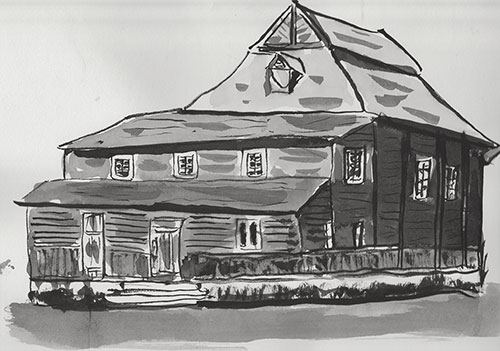Lost Treasures: The Wooden Synagogues of Eastern Europe The Artwork of Bill Farran
Wasilkow, Poland - Sumi-e Style Brush Painting
Wasilkow, Poland - Sumi-e Style Brush Painting
Yiddish name: Vashulkova
Wasilków is located seven miles from Bialystok. A Jewish community existed before 1694, when many arrived as refugees from Germany and were given certain privileges in the town. By 1807, the population was 677 inhabitants, with a Jewish majority, whose population increased during the mid-1800 due to the development of the textile and timber industries in the region. The town was inhabited by several groups of peoples with different religions and languages. In 1860 there were 1381 inhabitants, representing various religions: 65 Russian–Orthodox (Belarussians and Russian); 19 Evangelists (Germans); 817 Catholics (Poles and Lithuanians) and 480 Jews. This ethnic diversity played a role in inspiring a native son of Bialystok, Ludwig Zamenhof, to invent Esperanto in hopes of creating an artificial language that could unite the diversity of cultures.
On June 27, 1941, Wasilkow was occupied by German forces. The final liquidation of Wasikow's Jewish community began on the eve of November 2, 1942, when all Jewish people were transferred to a labor camp where many starved to death within a week or two. The survivors were crammed into cattle cars heading for Treblinka, where they were murdered in gas chambers upon arrival.
Purchase a print
Sumi-e Style Brush Prints are 8x10 inches, in an 11x14 matte.
